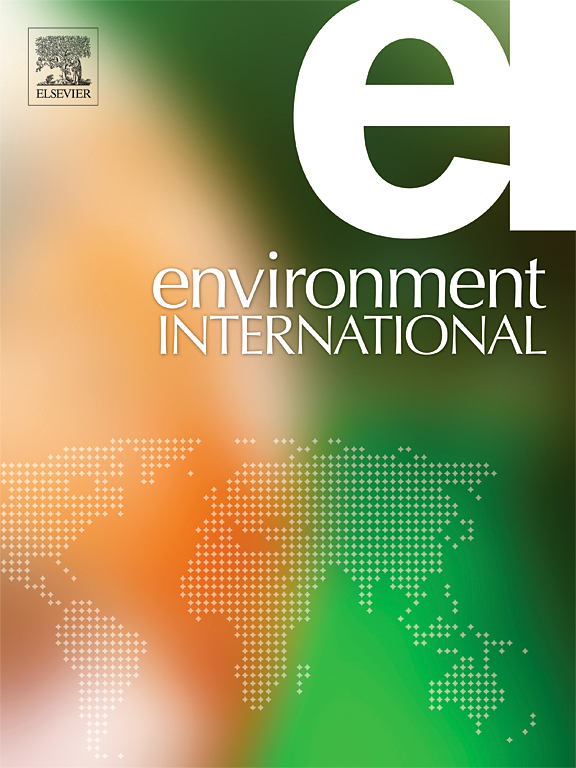The relationship between chronic air pollution exposure, neighborhood environmental vulnerability, and adverse COVID-19 morbidities among hospitalized New York City residents
IF 10.3
1区 环境科学与生态学
Q1 ENVIRONMENTAL SCIENCES
引用次数: 0
Abstract
Introduction
Communities disproportionately burdened by adverse neighborhood-level social and structural factors may experience greater vulnerability to environmental exposures, contributing to health inequities, including adverse COVID-19. We assessed the effects of chronic air pollution on COVID-19 morbidities in NYC and examined whether these effects varied by neighborhood-level vulnerability.
Methods
We used NYC COVID-19 hospitalization records (3/1/2020–2/28/2021) and conducted analyses in the full sample and within hospital catchment. Chronic air pollution (particulate matter (PM2.5), nitrogen dioxide (NO2), black carbon (BC), ozone (O3)) was assigned using residential ZIP Code (NYC Community Air Survey; 2009–2019). Modified Poisson regression estimated risk of acute respiratory distress syndrome (ARDS), pneumonia, ventilation, and dialysis, and Cox regression estimated risk of discharge, adjusting for age, sex, BMI, smoking, asthma, diabetes, and hypertension. We assessed effect modification by neighborhood-level environmental vulnerability index (NEVI) tertiles.
Results
From March to June 2020 (within hospital catchment), adjusted estimates generally suggest greater chronic NO2, PM2.5, and BC was associated with increased risk of ARDS, pneumonia, and dialysis, and not associated with discharge and ventilation; inverse estimates found for chronic O3. Relationships between air pollution and adverse COVID-19 were generally stronger among those with greater neighborhood environmental vulnerability. For example, chronic NO2 and pneumonia’s relationship was stronger in individuals within higher NEVI tertiles (T1: aRR: 1.13, 95%CI: 1.02–1.25; T2: aRR: 2.11, 95%CI: 1.73–2.56; T3: aRR: 6.36, 95%CI: 4.71–8.60).
Discussion
Differences in neighborhood-level social and structural factors contribute to unequal health burdens associated with air pollution. Public health resources targeted toward neighborhoods with greater environmental vulnerability can encourage population-level pandemic preparedness.


慢性空气污染暴露、社区环境脆弱性与住院纽约市居民COVID-19不良发病率之间的关系
受到社区一级不利社会和结构因素不成比例负担的社区可能更容易受到环境暴露的影响,从而加剧卫生不平等,包括不利的COVID-19。我们评估了纽约市慢性空气污染对COVID-19发病率的影响,并检查了这些影响是否因社区脆弱性而异。方法利用纽约市新冠肺炎住院记录(2020年3月1日- 2021年2月28日),对全样本和医院集水区进行分析。慢性空气污染(颗粒物(PM2.5)、二氧化氮(NO2)、黑碳(BC)、臭氧(O3))使用住宅邮政编码进行分配(纽约市社区空气调查;2009 - 2019)。修正泊松回归估计急性呼吸窘迫综合征(ARDS)、肺炎、通气和透析的风险,Cox回归估计出院风险,调整年龄、性别、BMI、吸烟、哮喘、糖尿病和高血压。采用邻域环境脆弱性指数(NEVI)对效果进行评价。结果2020年3月至6月(在医院集水区内),调整后的估计值普遍表明,较高的慢性NO2、PM2.5和BC与ARDS、肺炎和透析风险增加相关,而与出院和通气无关;对慢性臭氧的反向估计。在社区环境脆弱性较高的人群中,空气污染与COVID-19不良反应之间的关系普遍更强。例如,慢性二氧化氮和肺炎的关系在NEVI高分位数的个体中更强(T1: aRR: 1.13, 95%CI: 1.02-1.25;T2: aRR: 2.11, 95%CI: 1.73 ~ 2.56;T3: aRR: 6.36, 95%CI: 4.71 ~ 8.60)。社区层面社会和结构因素的差异导致了与空气污染相关的不平等健康负担。针对环境脆弱性较大的社区提供公共卫生资源,可以鼓励在人口层面上做好大流行病的准备。
本文章由计算机程序翻译,如有差异,请以英文原文为准。
求助全文
约1分钟内获得全文
求助全文
来源期刊

Environment International
环境科学-环境科学
CiteScore
21.90
自引率
3.40%
发文量
734
审稿时长
2.8 months
期刊介绍:
Environmental Health publishes manuscripts focusing on critical aspects of environmental and occupational medicine, including studies in toxicology and epidemiology, to illuminate the human health implications of exposure to environmental hazards. The journal adopts an open-access model and practices open peer review.
It caters to scientists and practitioners across all environmental science domains, directly or indirectly impacting human health and well-being. With a commitment to enhancing the prevention of environmentally-related health risks, Environmental Health serves as a public health journal for the community and scientists engaged in matters of public health significance concerning the environment.
 求助内容:
求助内容: 应助结果提醒方式:
应助结果提醒方式:


